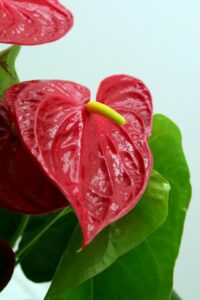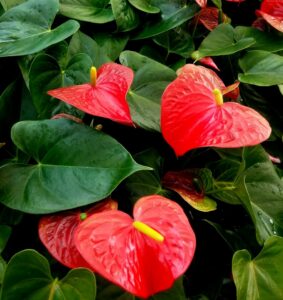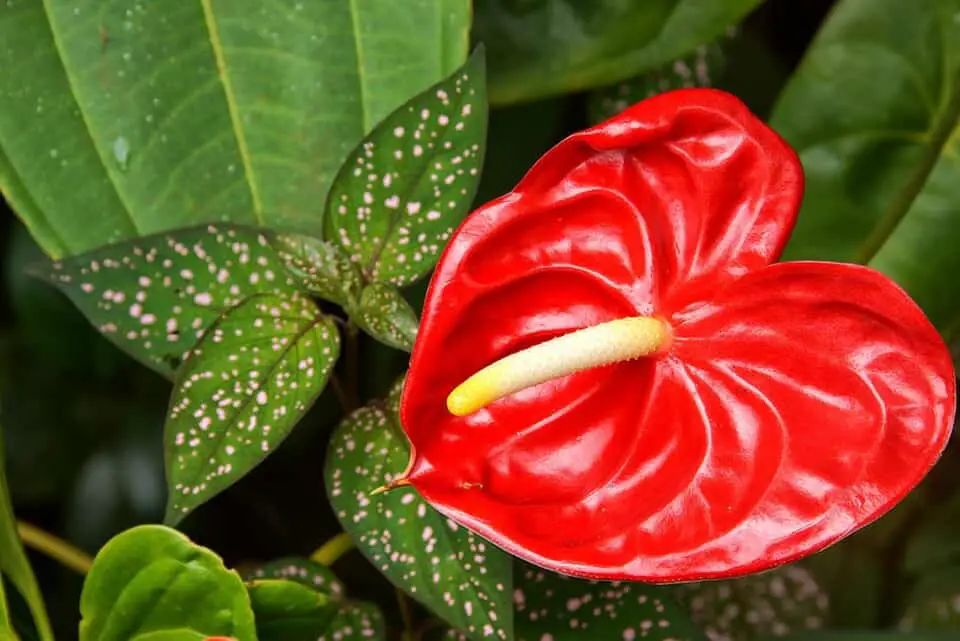Some links in the post are affiliate links and I get a commission from purchases made through some links found in the post.
Anthurium is the largest rubric in the family Araceae, consisting of ≈ 1000 species. Anthurium flowers are valuable for their fantastic shape, fragrance, and sizes.
Several species are available as cut flowers and as potted flowering leafage plants.
Anthurium is a plant known for its bright red flowers, making it a must-have for decorating your homes. If you plan to keep this plant in your home, you might have thought about where to place it depending on its light needs.
The good news is you’ve reached the right place. We will take you through what kind of light and how much your anthurium would need to survive.
An Anthurium plant needs medium to bright light to grow and bloom. They can do well in low light conditions if you aren’t expecting the plant to bloom.
The bright to medium light should be indirect, filtered through a window if kept indoors. Direct sunlight would be too harsh for the plant and can scorch and bleach the leaves.
If you want to learn more about how light effect your anthuriums growth and what light it requires then keep on reading.
What Type of Light does my Anthurium need?
 Light is an energy source for plant photosynthesis, although it can cause photodamage. Light is the most important environmental factor that influences plants.
Light is an energy source for plant photosynthesis, although it can cause photodamage. Light is the most important environmental factor that influences plants.
Plants exposed to a specific brightness are usually adapted to their light environment. For example, plants exhibit adaptability to different light conditions by modifying their photosynthesis.
Light is one of the essential requirements for every plant to grow and strive. Plants need light to photosynthesize, that is, to make their organic food.
This energy is what drives the plants to grow, flower, and produce seeds. Every plant has a different preference for the amount and type of light it prefers to grow in.
It is essential to know what kind of light suits your plant. And you must take care of your home plants and save them from an early demise. Plants are classified according to their light needs.
Which include high, medium, and low light requirements. The light intensity received by an indoor plant depends upon the plant’s light source.
Light intensity decreases as the distance from the light source increases. Window direction in a home or office affects the intensity of natural sunlight. Southern exposures have the most intense light.
Eastern and western exposures receive about 60 percent of the intensity of southern exposures. While northern exposures receive 20 percent of the intensity of southern exposure.
Southern exposure is the warmest. Eastern and western are less warm, and northern exposure is the coolest. Other factors such as curtains, weather, and window cleanliness also affect light requirements.
Reflective surfaces inside the home or office tend to increase light intensity. While dark surfaces decrease light intensity.
Anthurium, as already mentioned, needs bright to medium indirect natural sunlight. This doesn’t mean it can’t do well in artificial light.
Artificial light is becoming a popular way to grow plants. Also, in areas that do not get enough daylight.
Understanding what we mean by anthurium requires. Which is medium indirect sunlight. You need to know what types of lights there are. These include:
1) Low light:
Low light means a PPF of 50-150 umol m-2s-1 or 50-250 foot candles. Place the plants desiring low light near a north window or a dark corner.
Such plants need little to no direct sunlight. Such plants grow under the shade of taller, wider branched plants in nature.
Low light plants may need higher light to start seeding, so they should be propagated outside at the start. Low light plants require little watering, so you should be cautious not to overwater them.
Various indoor plants are sometimes exposed to low-light environments for a long time.
The plants with a high photosynthesis ability under low light adapt. And are able to survive by decreasing their light needs. Also, by increasing leaf size and chlorophyll contents.
But what if the plant gets too little light? The answer is that Plants that cannot get enough light will lose their color and die. Plants deprived of light will grow upward.
They stretch their stems, searching for light. This process is known as ‘etiolation.’ It is a survival mechanism that maximizes the plant’s chances of getting to light.
2) Medium light:
Medium-light means a PPF: 150-250 umol m-2s-1 or 250-1,000 foot-candles. Place a medium-light plant should near an east-facing.
It can also be placed in a west-facing window, away from direct light. Medium-light also isn’t enough for seeding and may need artificial light for this purpose. Such plants also don’t dry out and should be watered by assessing the soil.
Light is the most important variable influencing plant growth. If plants do not receive enough light, they will not grow at their greatest rate.
And may not be able to reach their potential, regardless of how much of any other variable they receive.
3) High light:
High light means a PPF of 250-450 umol m-2s-1 or more than 1,000 foot candles. Place a high-light plant near bright-lit locations such as south-facing windows.
High light plants generally dry out quicker and may need more watering than other plants.
Light is the driving force for photosynthesis. It is a plant process that changes sunlight into chemical energy.
A general rule of thumb is that 1% more light will give you a similar percentage increase in plant growth. Additionally, it will result in a 1% higher yield.
4) Artificial Light:
 Artificial light is an excellent way to grow plants in low-light areas. It can also be used to grow plants in difficult weather conditions, which demands growth indoors.
Artificial light is an excellent way to grow plants in low-light areas. It can also be used to grow plants in difficult weather conditions, which demands growth indoors.
It can be often used to propagate seeds before planting small plants outside.
Remember that some plants requiring high light may not need direct sunlight exposure. Indirect light means light filtered through any glass or window.
In contrast, direct sunlight means light that reaches the plant. Indirect light can also mean light reflected from any surface.
If an object placed in light casts a faint shadow, the light is indirect. If placing an opaque object in a light casts a dark shadow, the light is direct sunlight.
There is a natural growth cycle for every plant. The vegetative and flowering stages of growth are directly influenced by light.
Artificial lights allow for year-round development and quick production. But natural light has the intensity and nutrients that can never be duplicated. Without light, we would not have green plant life.
Also, vegetable gardens would not produce, and flowers would not bloom. Light gives food and energy to plants through photosynthesis and makes everything flourish. It is an essential part of all life on Earth.
If you’re enjoying this article, check out our article on what is the ideal humidity for an anthurium.
How Much Light Does an Anthurium Need?
An anthurium plant requires at least five to six hours of bright indirect sunlight to grow.
Putting anthurium in direct sunlight may burn the leaves. It will also retard its growth instead of promoting it.
What Happens if your Anthurium gets Too Little Light?
Anthurium plants do not produce enough chlorophyll when provided with too little light. They can turn pale to yellow. Anthurium can also become weak.
It means that the stems become longer and thinner as the plant tries to reach upward toward any light source. Lack of adequate light also causes spacing to develop between the leaf nodes.
Too little light may trigger the plant to start shedding or dropping its older leaves to sustain. Anthuriums getting too little light will have fewer flowers. Also, it will grow slower. They may also fail to produce flower buds.
What Happens if your Anthurium gets Too Much Light?
The answer to this is that this can deplete the plant’s water reserves with time. And it will leave insufficient water for vital processes such as photosynthesis.
If the ability of the plant to release heat decreases, it will get damaged. Also, if the amount of heat produced exceeds the plant’s ability to dissipate it, the plant will suffer.
This often presents as yellow or brown spots on the leaves. They might represent yellow leaves. They may have brown crispy leaf edges or tips or curled, dropping leaves.
Light intensity might also dry the soil from which the plant draws moisture. It will lead to accelerated plant dehydration. It can harm a plant in a variety of ways. But different plants have a different tolerance levels to light intensity.
Plants exposed to too much light may face scorching and bleaching of their leaves. The plant can become dehydrated because the light evaporates the water.
Dehydration appears as leaves start to fade and develop white and brown patches. The flowers also fade.
Where to Place your Anthurium to get the Best Light?
Since the Anthurium plant desires bright to medium indirect sunlight, it is best to place the pot near an east or west-facing window.
It should be away from direct sunlight. The reason is that this would provide you with medium-intensity indirect bright light.
You may also like: Why is your anthurium flower bud turning brown
Can Anthuriums Grow in Artificial Light?
Researchers can grow plants using only artificial light in growth chambers. But sunlight is best for most plants. It’s generally more intense than artificial light. It is well distributed among the different wavelengths.
Also, it is important to note here that can artificial light harm plants? So the answer to this question is here. Artificial light sources may affect the natural night and day cycle of the plants. It may affect the ecology they support.
LED lights are an effective way to grow plants at home. They use low energy and low heat and are helpful for the plant’s growth. They produce better growth than fluorescent lights or incandescent lights.
It is important to consider that LED lighting for plant growth can be used with ease and tuned according to liking. It can also be done to generate the most desirable form of chlorophyll. The plant needs chlorophyll at each stage of its growth cycle.
How to Grow an Anthurium using Artificial Lights?
Not much research is available on the anthurium’s need for artificial light. to check its growth in the presence of artificial light.
Thus, limited data is present in this regard. Still, according to the analysis, there is a need for more than 15 watts of light. At least 15 watts isn’t enough light to grow much of anything.
Thus, at least 30 watts per square foot of average light is required. Also, it’s important to keep most plants, especially those you want to bloom, within one foot of the light.
Good reflectors will help compensate for distance. but if your plant has to be two feet down, you might want to consider something with is more appropriate. These include things like T5’s, essence halide, or natural sun of course.
Light quality has a pronounced effect on plants’ growth and development. The light source generally used for tissue culture is broad-spectrum fluorescent lights.
They have peak wavelengths from 380 to 750 nm. LEDs have many advantages over conventional fluorescent lights. These include specific wavelengths.
Also include low thermal output and adjustable light intensity. And high photoelectric conversion effectiveness as well as small size and extended life.
These make LEDs adaptable for supporting plants growth in tissue culture areas and growth chambers.
Final Thoughts
 After a deeper analysis, we came to the conclusion that anthuriums need a high light but not direct sun. Anthurium plants can tolerate all situations of indirect light.
After a deeper analysis, we came to the conclusion that anthuriums need a high light but not direct sun. Anthurium plants can tolerate all situations of indirect light.
Anthuriums growing in low light will have smaller flowers and will grow slower. These plants cannot tolerate direct sunlight as this can burn the leaves. It grows best in bright, indirect light.
It is important to remember that light is food for plants and drives their nutrition for them.
Make sure to understand how much natural sunlight your plant needs. And how much light your space can provide before making your plant selections.
Before you go, here are some more related articles I encourage you to read below to help solve more of your gardening issues:
Why Does Your Anthurium Have Holes In Its Leaves
How to Solve Anthurium Leaf Problems
About the Author:
Saad Ansar
Saad is an avid gardener himself and is a great lover of plants, animals, photography, & people. Currently, he is focused on photographing indoor plants & captioning beautiful outdoor sceneries. He writes and rewrites in-depth articles on nature and science.


